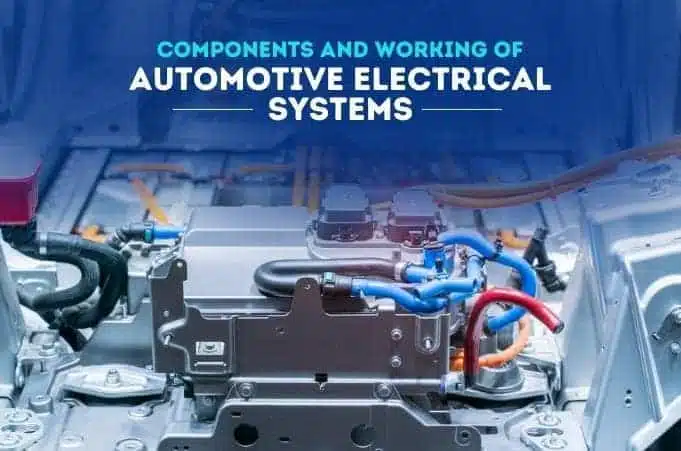
The automotive electrical systems and automotive electrical engineering industry have hyped the popularity of electric and hybrid vehicles. The advancements in vehicular technology with safety features, infotainment, body electronics, and powertrain have flooded the sector with increased demand. With respect to the same demand, the expected market size of automotive electronics is valued at $8.12 billion by 2028, with a CAGR of 7.48% every year.
From classic electronics to passive safety features, automotive electrical Engineering comprises it all. All these features draw their power from a battery. It is a loop where the current flows from the positive terminal of the battery to generate an output like the lighting of gauges and flows back to the negative terminal.
Thus, to get a basic understanding, this article will briefly explain how Automotive Electrical Engineering and automotive electrical systems work.
What is an automotive electrical system & automotive electrical engineering?
The automotive electrical systems & automotive electrical engineering include engine management, ignition, radio, telematics, car puters, infotainment systems, and many more. This system primarily generates, stores, and supplies electricity to vehicle systems. It also controls vehicle electrics like electrical gauges, digital gadgets, power windows, central locking mechanisms, etc.
Components of an automotive electrical system
- Magneto
Also known as ignition magneto, is a magneto (electrical generator that uses permanent magnets to produce alternating current) that provides current for the ignition system for a spark-ignition engine, like, a petrol engine. It consists of 3 components-
- Permanent magnets
- Coil
- Cranking mechanism
This converts mechanical energy into electrical energy. With a constant magnetic field strength, it generates a steady output regardless of load variations.
- Generator/Dynamo
It supplies the electrical energy for charging the battery that gets the drive from the engine through the fan belt. The generator converts mechanical energy into electrical energy, i.e., direct current (DC). This is because the electric components need DC to function, which they can directly consume. It consists of 3 components-
- Frame
- Armature
- Field coils
A Dynamo takes the help of a commutator and uses rotating coils and a magnetic field to convert mechanical rotation into an electrical supply. They are placed on the tires of electric cars to produce energy and to maintain the efficiency of the car even when the accelerator is not pressed.
- Alternator
Also known as AC generator. It is an inevitable part of a vehicle’s charging system. The alternator provides the electrical power that charges the battery, however, the current produced is alternating current (AC). Because vehicles use a 12-volt DC electrical system, this alternating current (AC) power is quickly converted to direct current (DC).
It consists of 4 components-
- Frame or housing
- Rotor with electromagnets
- Stator
- Slip rings and bushes
Its efficiency is not limited to fan cooling loss, bearing loss, iron loss, copper loss, and the voltage drop in the diode bridges, but also extends when combined with permanent magnets.
- Cut-out relay
Also known as a circuit breaker, regulates and cuts the current output going to the battery. When the engine is running at low speeds, the generator output is frequently lower than the 12-volt battery output voltage. As a result, it is insufficient for charging the battery.
Because the battery voltage is greater than the generator output, in this case, the battery begins to drain into the generator. A voltage regulator/Cut-Out is used to prevent the battery from draining. It is responsible for connecting and disconnecting the generator from the battery.
The DC generator is connected to a battery through a cut-out relay and an ammeter. It also maintains the voltage between 13.5 and 14.5 volts to protect other electric parts in the vehicle.
- Battery
The battery stores electrical energy in DC form for future use. The positive terminal is directly connected to the engine starter motor. It aids in starting the engine by cranking the starter. The alternator immediately charges the battery while the engine is running. When the engine is turned off, the battery can power the electrical components.
Working principle of an automotive electrical system
- The Automotive electrical systems in a vehicle are designed with switches or relay systems and are connected to the battery.
- When the engine starts, the electrical motor receives power from the battery.
- Via the combustion process, the engine keeps running and the alternator keeps charging the battery.
- When the engine slows down, the cut-off cuts the power between the battery and the generator.
- The alternate output voltage is maintained above the battery voltage to prevent it from draining and ensure smooth operation.
Summing Up
automotive electrical engineering work on the simple principle of electromagnetic induction. They are responsible for advanced automotive features like ABS, ASR, PA, airbags, emergency brakes, driver assistance, navigation systems, and passenger comfort systems. This requires the immense assistance of tools, both hardware and software.
Technosoft is an automotive electrical engineering services provider company. We offer an extensive portfolio of product solutions, including
- Designing and developing individual electrical components
- Chassis Electronics and Power Distribution
- 2D and 3D Wiring Harness Routing
- Wiring Harness Design
- Climate Control and Body Electronics
- Electrical Components Selection
- Electrical & Electronics Schematic System Design
- Manufacturing Process Setup
- Value Analysis/Value Engineering
We try to merge the latest technology and serve advanced products to our clients!